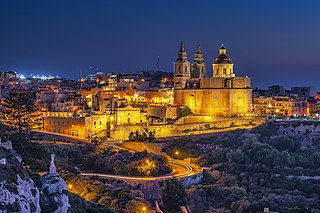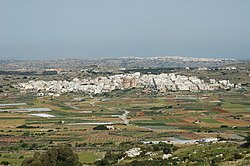
Mellieħa is a large village in the Northern Region of Malta. It has a population of 10,087 as of March 2014. Mellieħa is also a tourist resort, popular for its sandy beaches, natural environment, and Popeye Village nearby.

Rabat is a town in the Western Region of Malta, with a population of 11,497 as of March 2014. It adjoins the ancient capital city of Mdina, and a north-western area formed part of the Roman city of Melite until its medieval retrenchment.

San Ġwann is a town in the Northern Region of Malta, with a population of 14,244 as of 2021. Prior to its establishment as a distinct municipality, it was a fragmented community comprising parts of Birkirkara and St. Julian's. San Ġwann emerged as a new parish in 1965 and was officially recognised as a town in 1968. The Local Councils Act of 1993 identified San Gwann as a separate district with its own statutory local government authority, marking its transition from being part of the neighbouring localities. With the first San Gwann Council was elected on 16 April 1994.

Għajn Tuffieħa Tower is a small watchtower in Għajn Tuffieħa, limits of Mġarr, Malta. It was completed in 1637 as the second of the Lascaris towers. The tower is mostly intact although it is threatened by coastal erosion and was damaged during a storm in 2023.

Iklin is a village in the Central Region of Malta, with a population of 3,247 as at 2021. Iklin was established in the mid-20th century; however some archaeological sites and a medieval chapel, named as St. Michael Chapel, are proof to earlier settlements. Until recently, the town was considered to form part of the Three villages of Malta, as part of Lija. With the separation of Iklin from Lija, Iklin is no longer part of the three villages. It is bordered by Għargħur, San Ġwann, Birkirkara, Balzan and Naxxar.

Għajnsielem is a municipality on the southeastern coast of the island of Gozo in Malta, including the entire island of Comino. It has a population of 3,200 residents, and is the first Gozitan village that greets the visitor on leaving Mġarr Harbour towards the Gozitan heartland. Its name originated from the water spring, around which in 1700, Grandmaster Perellos built an arcade containing public wash basins and fresh water spouts. Attractions include Lourdes Chapel with its sharp steeple and underlying niche of Our Lady of Lourdes, Fort Chambray and the towering of Ghajnsielem Parish Church.

Qala is an administrative unit of Malta, on the island of Gozo, with a population of 1,929 as of September 2019. Nearby is Ħondoq ir-Rummien, a coastline with salt pans and caves.

Marsaskala, sometimes written as Marsascala is a seaside town in the South Eastern Region of Malta. Originally a fishing village, it has grown into a tourist destination and a permanent hometown for an ever-growing population.

Malta is for non-local government purposes divided into districts as opposed to the local government regions at the same level. The three main types of such districts – statistical, electoral at national level, and policing – have no mainstream administrative effect as the regions and local councils function as the only administrative divisions of the country.
This page list topics related to Malta.

The coastline of Malta consists of bays, sandy beaches, creeks, harbours, small villages, cities, cliffs, valleys, and other interesting sites. Here, there is a list of these different natural features that are found around the coast of Malta.

Ġnejna Bay is a popular tourist destination located about 1 kilometer from the village of Mġarr on the western coast of Malta. The beach surrounding the bay is mostly sandy. A secluded strip of shore under the steep cliff on the northern side of the bay is a popular nudist beach, although the practice is technically illegal in Malta and frowned upon by the conservative Catholic population.
The Lascaris Towers are a series of mostly small coastal watchtowers built in Malta by the Order of Saint John between 1637 and 1652. The first seven towers were built around the coast of mainland Malta in 1637 and 1638. Between 1647 and 1652, a large tower was also built on mainland Malta, and two smaller ones were built on Gozo.
Post codes in Malta are seven-character strings that form part of a postal address in Malta. Post codes were first introduced in 1991 by the mail operator MaltaPost. Like those in the United Kingdom and Canada, they are alphanumeric.

In Malta, most of the main roads are in the outskirts of the localities to connect one urban area with another urban area. The most important roads are those that connect the south of the island with the northern part, like Tal-Barrani Road, Aldo Moro Street in Marsa and Birkirkara Bypass.

The Northern Region is one of six regions of Malta. The region includes the northwestern part of the main island of Malta. The region borders the Eastern, Southern and Western Regions, and is also close to Gozo Region.

The Parish Church of the Assumption of the Blessed Virgin Mary into Heaven is a Roman Catholic parish church in Mġarr, Malta, dedicated to the Assumption of Mary. It was constructed between 1912 and 1946 on the site of an earlier church which had existed since around 1400. The building has a large dome with an elliptical plan; this shape is said to have been chosen because of its similarity to an egg, so as to encourage residents to sell eggs to raise funds for its construction.

There are over 300 protected areas in Malta which have a wide range of national and international protection statuses.


















